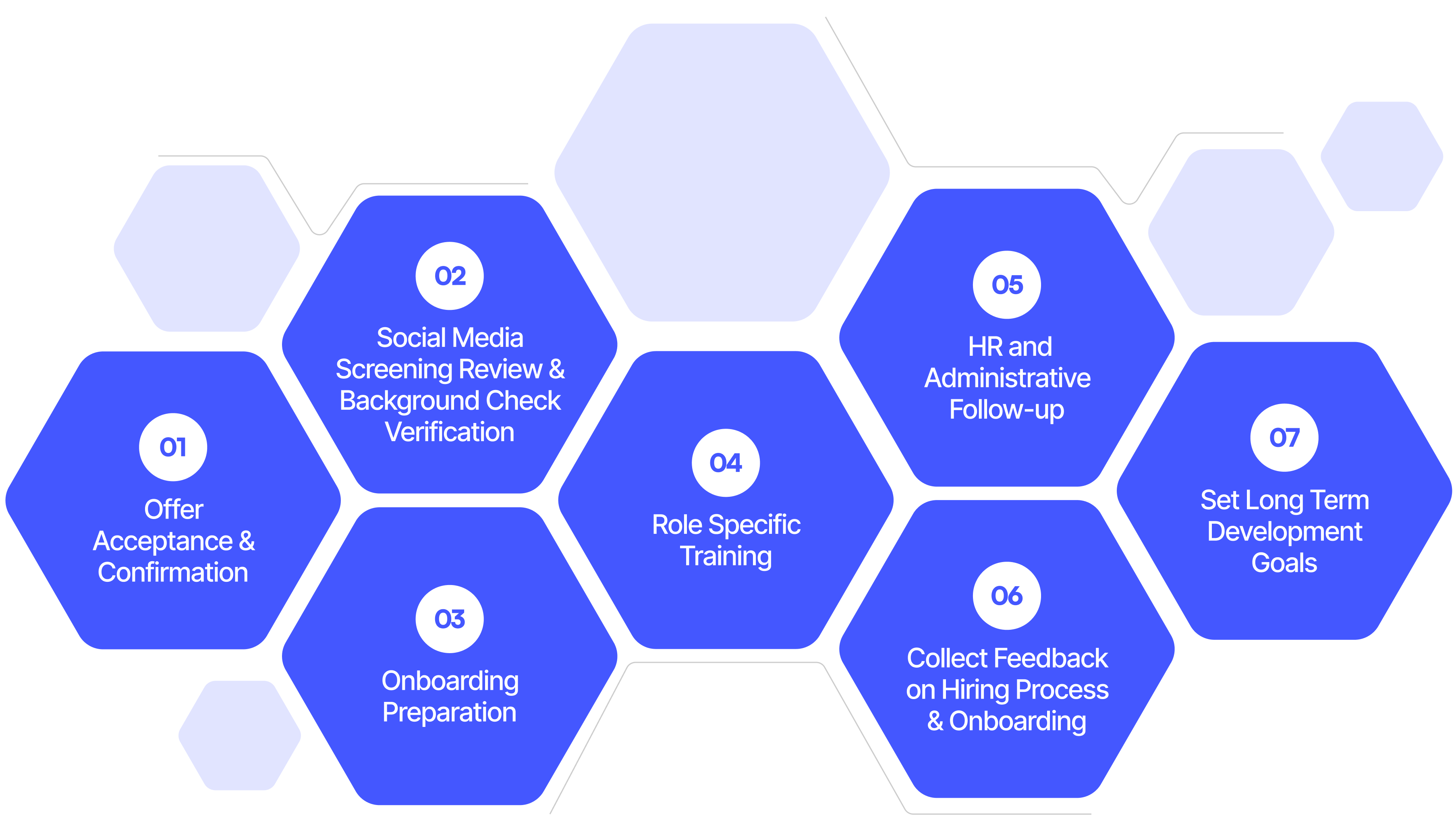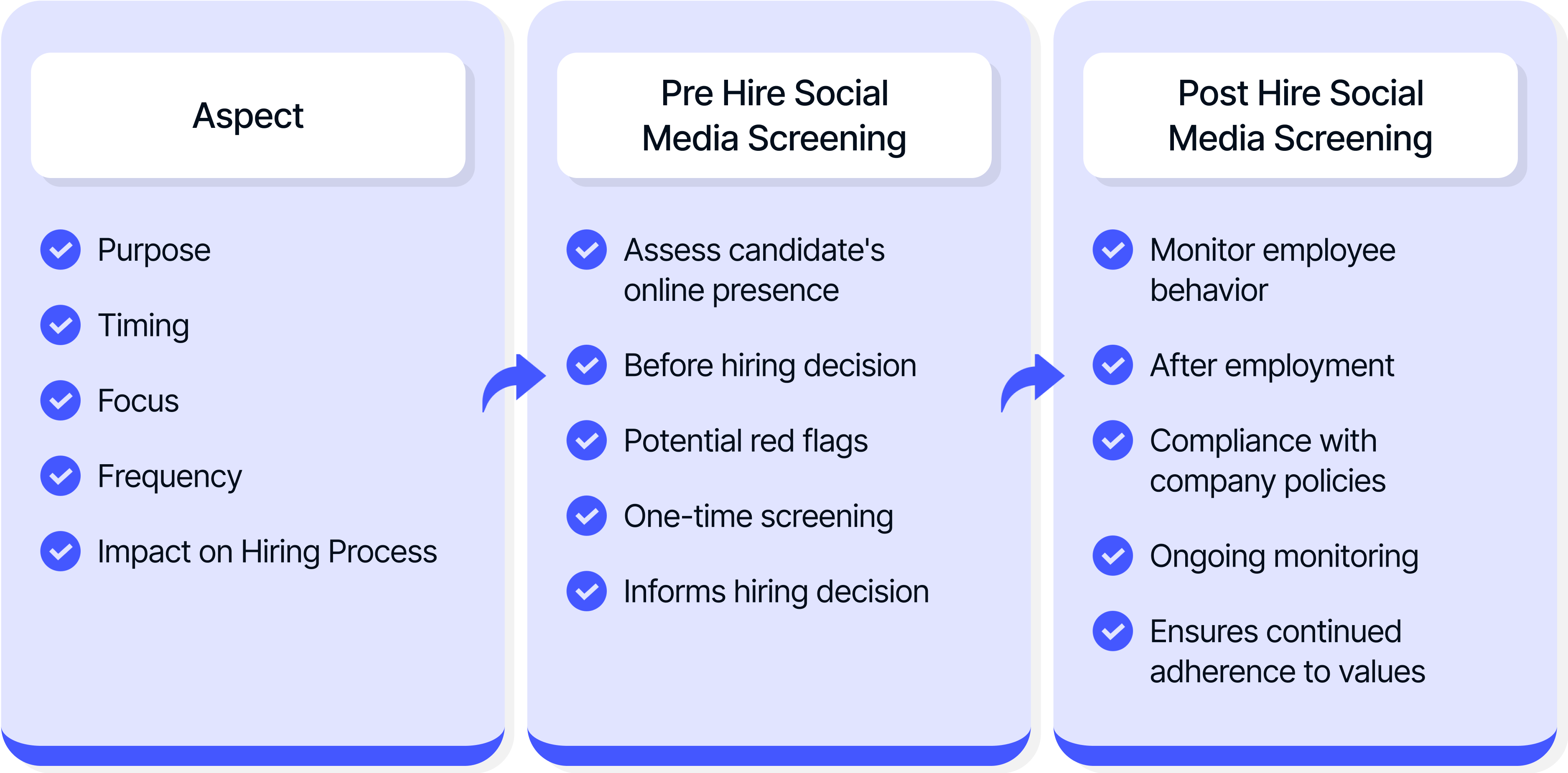What are the Pre and Post Phases of the Hiring Process?

The hiring process is important for every organization, but it often comes with significant challenges. From struggling to find qualified candidates to navigating the difficulties of background checks, hiring can be time-consuming and filled with uncertainty.
Many employers face issues like high turnover rates and biased evaluations, which can lead to costly mistakes. Understanding the pre and post phases of this process is important for overcoming these challenges.
We will explore these phases in detail in this article, highlighting how tools like social media screening can improve candidate evaluation and how reducing hiring bias can improve the overall hiring experience. We will also discuss how behavior analysis can provide valuable insights into potential hires.
What is Recruitment?
Recruitment is the first phase of the hiring process, which includes the vital tasks of identifying, attracting, and selecting suitable candidates for job openings. This stage is important as it sets the foundation for the entire hiring journey.
The recruitment process entails advertising job vacancies across a variety of platforms, such as job boards and social media, to clearly communicate job roles, responsibilities, and required qualifications. Recruiters actively search for qualified candidates through databases, and networking events often making use of technology like Applicant Tracking Systems (ATS) to streamline their efforts.
Inviting applications involves reaching out to candidates, which may include personalized messages to engage their interest. Effective recruitment focuses on building a talent pool for both current and future job openings, maintaining relationships with previous applicants.
Pre Phases of the Hiring Process

The pre-hiring phases cover the essential steps an organization takes before selecting a candidate. These steps help ensure the organization understands its needs and develops a solid plan for finding suitable candidates. Let’s take a closer look:
1. Identify Hiring Needs
The first step is to identify hiring needs by determining which roles need to be filled and the reasons behind them. Organizations should assess their current workforce to pinpoint any skill gaps, ensuring they have a clear picture of the skills and experience required in new hires.
2. Create a Job Description
After clarifying hiring needs, the next step is to develop a job description. This document details the key roles and responsibilities of the position, as well as the necessary skills and qualifications. A Good job description attracts suitable candidates and provides them with a clear understanding of the role.
3. Establish a Hiring Budget
Setting a hiring budget is an essential step that follows. This budget accounts for expenses related to recruiting, interviewing, and onboarding new employees. Defining a budget helps the organization manage its resources efficiently and prevents overspending.
4. Plan a Recruitment Strategy to Find Talent
Using a recruitment strategy is important for attracting and finding the right candidates. Organizations can use different ways to do this, such as online job boards, social media, and recruitment agencies. A good strategy helps reach more people and increases the chances of connecting with qualified applicants.
5. Set Up an Applicant Tracking System
An Applicant Tracking System (ATS) is a software tool that helps make the hiring process easier. It lets organizations keep track of applicants, set up interviews, and organize resumes. Using an ATS simplifies hiring and helps manage candidate information better.
6. Outline Interview and Assessment Processes
Defining the interview and evaluation processes is important. This step includes deciding how candidates will be interviewed and what criteria will be used to evaluate them. Having clear processes ensures that all candidates are treated fairly and evaluated consistently.
7. Prepare Screening Criteria
Establishing screening criteria includes creating a list of factors to evaluate candidates. This may include qualifications, experience, and skills. Clear screening helps reduce the candidate pool and identify the best candidates for interviews.
8. Background Check
A background check is a crucial step in the hiring process. It involves verifying the information provided by candidates, such as their education and work history. A background check ensures that candidates are honest and fit for the job. For more details on what a background check means, visit our article on background check means. It is also important to understand the types of background check and look for any background check red flags.
9. Social Media Screening
Social media screening is an important part of the hiring process. This involves reviewing candidates' social media profiles to see their online behavior. Modern recruiters use this method to gather more information about candidates. For a more in-depth look at this topic, check out our article on social media screening and learn how modern recruiters are using these tools.
10. Evaluation and Offer of Employment and Onboarding
After evaluating candidates, the organization selects the one who best fits the role. The chosen candidate is then given the job offer. Once the candidate accepts the offer, onboarding begins. Onboarding is the process of introducing the new employee to the organization and its culture.
Post Phases of the Hiring Process

The post-hiring phases happen after a candidate is hired. These steps help ensure that the new employee is successfully welcomed into the organization. Let’s look at these phases in detail:
1. Offer Acceptance and Confirmation
Once a candidate accepts a job offer, the organization needs to confirm that acceptance. This includes giving the new employee all the important information about their job, salary, and benefits. Clear communication helps everyone have the right expectations.
2. Social Media Screening Review and Background Check Verification
After the offer is accepted, it's important to conduct a final review. This includes checking the social media screening results and verifying the background check information. This step helps ensure that the candidate has given accurate information throughout the hiring process.
3. Onboarding Preparation
Onboarding preparation includes planning how to welcome the new employee with getting training materials ready, setting up their workspace, and assigning them to a mentor. A well-organized onboarding process helps new employees feel at ease and supported.
4. Role-Specific Training
Role-specific training helps new employees understand their job tasks and get up to speed faster. It includes the essential skills, tools, software, and processes they’ll use, along with company standards and best practices.
Tailoring training for each role helps employees feel confident, shorten their learning time, and start making an impact sooner. This method supports new hires and prepares them well for success.
5. HR and Administrative Follow-up
HR and administrative follow-up ensures new hires complete all essential paperwork, such as tax forms, benefits enrollment, direct deposit setup, and any legal documents required by the organization.
Managing these tasks properly helps prevent payroll, benefits, and compliance issues, providing a smooth experience for the employee. This follow-up may also include arranging an orientation session to go over company policies, health and safety guidelines, and available resources.
6. Collect Feedback on Hiring Process and Onboarding
Gathering feedback on the hiring and onboarding process provides helpful insights for making improvements. Feedback can be gathered through surveys, interviews, or informal check-ins during the first few weeks and at the end of onboarding.
Asking new employees about their understanding of job expectations, the quality of training, and overall experience helps the organization identify areas needing improvement and recognize patterns that may affect future candidates' experiences.
7. Set Long-Term Development Goals
Creating long-term development goals with new employees supports their career growth while helping the organization succeed. These goals can focus on building skills, meeting performance benchmarks, or planning career progression, aligning with both employee ambitions and company goals.
Regular check-ins help maintain motivation, give direction, and show the organization’s dedication to their growth.
Benefits and Challenges of the Hiring Process
The hiring process has several benefits and challenges that organizations should consider.
Benefits of the Hiring Process
- Attracting Talent: A clear hiring process helps bring in highly qualified candidates.
- Better Cultural Fit: A structured approach ensures new hires align well with the culture of organization.
- Skills Matching: good process connects candidates’ skills to the specific needs of the role.
- Lower Turnover: Finding the right people for the job helps organizations keep their employees longer.
- Better Reputation: A good hiring experience makes the organization look better to job seekers.
- Following the Law: Following a clear hiring process helps organizations meet labor laws.
- Diversity and Inclusion: A fair hiring process encourages a mix of different backgrounds in the workplace.
- Smart Decisions: Organizations can use information collected during the hiring process to make better choices.
Challenges of the Hiring Process
- Takes a Lot of Time: The hiring process can take a long time, which can slow down the process of onboarding new employees.
- Requires Many Resources: Hiring needs a lot of resources, including time and money.
- Can Be Unfair: Hiring bias can cause unfair judgments about candidates.
- Different Opinions: different judgments from different interviewers can result in confusion for everyone included.
- Too Dependent on Technology: Tech can be beneficial, but depending heavily on it may mean missing out on chances.
- Negative Candidate Experience: A slow hiring process can cause candidates to think negatively about the company.
- Lots of Competition: Because many businesses are looking for the same skilled employees, finding the best candidates can be hard.
- Legal Problems: Bad hiring decisions can create legal implications for organizations.
Pre Hire vs. Post Hire Social Media Screening and Background Check

How Does Ferretly Help in Pre and Post Phases of the Hiring Process?
Ferretly provides AI-driven solutions that improve the hiring process. Our platform offers tools for both the pre and post-hiring phases, assisting organizations in making well-informed decisions.
By simplifying the hiring process, Ferretly helps save time and resources in recruitment, addressing issues related to long hiring durations and intense competition for talent.
Our data-driven insights empower organizations to make smart choices, enhancing skill matching and cultural alignment, which can result in reduced turnover rates.
Our social media analyst can assist in evaluating candidates' online behavior effectively. If you want to see how our platform can improve your hiring process, feel free to Request a Demo.
Frequently Asked Questions
1. How long does the hiring process usually take?
The duration of the hiring process can vary widely based on the company and the specific job. It can take anywhere from a few weeks to several months. Factors like the number of applicants and the complexity of the role can influence how long it takes to find the right candidate.
2. What role does technology play in the hiring process?
Technology plays an important role in modern hiring. Tools like Applicant Tracking Systems (ATS) streamline the process by organizing candidate information and enhancing communication. This allows hiring teams to focus more on identifying the best candidates rather than collecting paperwork.
3. Why is feedback important in the hiring process?
Feedback from candidates and new hires is invaluable for organizations. It helps improve hiring practices, ensuring a better experience for future applicants. Plus, collecting feedback can improve the employer brand of the company, making it more suitable for top talent.
4. How can organizations reduce bias in the hiring process?
To reduce bias, organizations can use structured interviews, create diverse hiring panels, and use technology to evaluate candidates objectively. These approaches not only promote fairness but also help bring large range of perspectives to the team
5. What are the effects of a poor hiring process?
A poor hiring process can lead to high turnover rates, low employee morale, and even legal issues, all of which can risk an organization’s success. It can increase recruitment costs and damage the reputation of a company in the job market.
Conclusion
Understanding the pre- and post-hiring phases is important for any organization. By managing these stages, companies can attract and retain the right talent, contributing to their overall success.
Using tools such as social media screening and background checks can improve these processes, providing a thorough evaluation of candidates. As hiring practices include, organizations must remain adaptable and concentrate on effective recruitment strategies.
For more insights into hiring practices, take a look at our articles on background checks and social media screening.






